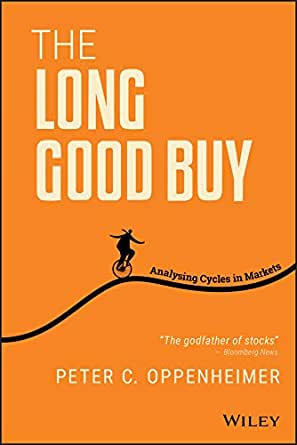The Long Good Buy is a book in which Goldman Sachs Equity Strategist Peter Oppenheimer explores the fascinating interconnectivity of the real world and financial markets.
Central to the book is the notion that despite the world going through periods of:
- High and low output
- High and negative interest rates
- Tightly and loosely controlled financial markets
One constant throughout has been the unyielding ebb and flow of the financial and economic cycles.
What causes these cycles? Can they be predicted? Can we use information from one cycle to inform our view of what will happen in others? These are the questions explored by Peter in The Long Good Buy.
Peter offers to make sense of a thousand moving parts driving investor and market behaviour.

FE Rating: 3.5/5
Price: Click here to check latest price on Amazon
This pattern of swell and contraction has continued unabated. Despite all of the other inputs; the gears and levers of financial markets as you will, continually evolving through very different combinations.
The Long Good Buy is about choosing the right moment
If we step back. This is macro economics book about market timing. Market timing is the slightly controversial idea that with appropriate insight, investors can increase their chances of predicting when is the right time to buy shares and when is the right time to sell.
As Peter goes on to conclude:
“Over the long run, even accepting the fluctuations caused by cycles, investing can be extremely profitable. Different assets tend to perform best at different times, and returns will depend on the risk tolerance of the investor.
But for equity investors in particular, history suggests that, if they can hold their investments for at least five years and, especially, if they can recognise the signs of bubbles and of inflection points in the cycle, they can benefit from the ‘long good buy’“
Market timing, which is part of the active investing school of thought, is not followed by all investors. But for those who attempt to ride the wave of bull markets while escaping the pain of market crashes, this will be extremely relevant.
The audience
The impression I was left with is that The Long Good Buy is aimed at existing investors or finance professionals with a keen interest in economics. New acronyms sometimes go undefined, and the author expects the reader to understand the distinction between the business cycle and the financial cycle, for example.
(Explainer: the business cycle is the rise and fall of the real economy, whereas the financial cycle is the rise and fall of the stock market).
I peg this book at the intermediate to sophisticated investor level. Anyone who is looking to refine their understanding of buy and sell signals will gain a lot from this book.
The chapters have an academic feel, as they contain longer sentences than you find in more accessible financial journalism.
This is a book which investigates correlation and causation, therefore don’t expect it to gloss over the detail. Expect to see insightful charts that you’ve never thought to look for before, delivering visual answers to questions such as:
- How has the correlation between equity and bond returns trended over the last century?
- Which asset classes perform the best when inflation is rising, or manufacturers confidence is rising, and vice versa?
Continuing with the academic theme, you’ll find complete references for further reading at the footer of each chapter.
FE investing book rating for The Long Good Buy
I award this book 3.5 out of 5 stars, earning it a position of the Financial Expert best investing books list.
I really enjoyed watching the author connect the dots between a web of factors such as:
- Investor willingness to take risks
- The global flows of capital
- The power of consensus acting as an ‘override’
And feel that my understanding of the ‘mechanism’ that drives the cycles of the markets has developed considerably from reading this book.
Value for money
The Long Good Buy is currently available on Amazon UK for just under £22. This places it within the top end of the range for our top 10 guide.